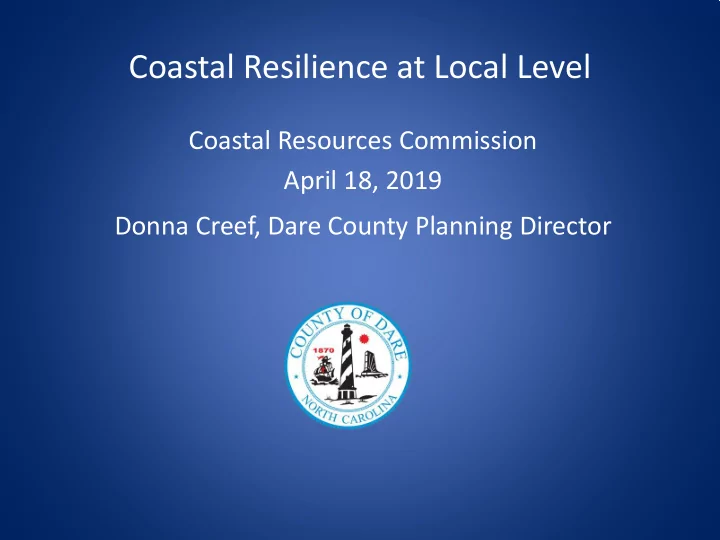

Coastal Resilience at Local Level Coastal Resources Commission April 18, 2019 Donna Creef, Dare County Planning Director
Resilience At Local Level • Dare County’s ability to effectively respond to and address the hazards and influences impacting our community. • Impacts to our public infrastructure, residential and commercial properties, natural resources, and local economy. • Both short-term and long-term responses to specific events and future conditions.
Resilience at Local Level • Historical -- Coastal communities have been practicing resiliency for decades just not called resiliency. Construction practices of coastal communities, past recovery from multiple events. • Future -- Identification of new management tools to address impacts from more frequent, intense events to changing conditions.
Resilience at Local Level • Education of property owners and residents on hazards through outreach activities. • Mitigation of hazards and flood risks through regulation and assistance to property owners.
Resiliency Through Education • Dare County is a participant in the NFIP Community Rating System. The CRS program is a voluntary program in which local governments implement outreach activities and higher regulations to mitigate flood hazards. • Dare County property owners currently receive a 15% decrease on policies.
CRS Activities • In 2017, Dare and six towns joined efforts on CRS outreach activities to present unified CRS message. • Slogan – “Low Risk is not No Risk”. • Brochure on flood risks, protection measures, and flood insurance. • Webpage – OBXFloodmaps.com
CRS Slogan
CRS Brochure
Mitigation-Living Shorelines • Construction of living shorelines along estuarine shoreline areas. • Living shorelines respond better to storm conditions than traditional bulkheads. • Cooperative efforts with non-profits, government agencies, and property owners.
Mitigation Efforts Living shoreline projects can be constructed with CCAP (community conservation assistance program) grants. These grants are cost-shared by property owners and State funds. Dare Soil and Water staff administers CCAP grants.
Mitigation Efforts • Since 1999, Dare County has elevated over 72 homes with HMGP grant funds and other FEMA mitigation funds. Pending applications of 24 homes for FEMA funding. • Since 2011, 143 homes have been elevated by property owners with insurance (ICC) funds and private funding. ICC provides up to $30,000 to property owner.
Eagle Pass Road Hatteras FEMA Mitigation Project Elevated in 2016 with HMGP Funds FFL 10.6’
Resiliency Through Regulation • National Flood Insurance Program participant since 1978. • Local ordinance includes 1-foot freeboard that was enacted in 2014. • Currently working on Local Elevation Standard in response to revised FIRMs.
Flood Maps in Dare • Current flood insurance rate maps (FIRMs) were adopted in 2006. • Revised preliminary maps released for Dare County on June 30, 2016. Hope to have letter of final determination later this year for adoption of revised maps in 2020. • Developed OBXfloodmaps.com for centralized information source for property owners.
Revised FIRMs for Dare • Now- 14,703 properties AE zone and VE Zone (12,875 AE properties and 1828 VE properties on 2006 maps.) • Revised maps --11,627 properties total • 8,493 AE zone (decreased BFE AE8 – AE4) • 120 AO zone (new for Dare) • 124 VE zone (moved to Shaded X or AE zone) • 2,890 Shaded X zone (reclassified) • 3,076 X zones
Concerns About Maps • Historically flooded areas will be designated as X zones, Shaded X, or in AE zone with decreased BFEs. • Revised maps may not accurately reflect soundside flooding hazards or extreme rainfall amounts. • Failure to realize risk, assume there is no risk in X zones/Shaded X zones. Property owners choose to discontinue flood insurance coverage.
HATTERAS VILLAGE Effective Map Revised Map Shaded X AE Zone VE Zone
Eagle Pass Road Hatteras FEMA Mitigation Project 2006 AE 8.0 + 1’ FB PRELIMINARY AE 4.0 FFL 10.6’ AE4.0 +1’ FB LAG 2.0’
Approximate Tide Line Hurricane Matthew
Irene Flooding -- Rodanthe AE 5 or AE 4 Shaded X Zone VE Zone Major Flood Damage
COLINGTON Effective Map Effective Map AE 8 Shaded X AE 8 or AE 9 VE 11 or VE 10 Preliminary Map AE 4 Shaded X X Zone Major Flood Damage
COLINGTON 2006 FIRM AE 8.0 REVISED AE 4.0 FFL 11.3’ AE4 + 1’FB GRADE 3.2’ Harbour View Drive
Proposed Regulations • Developing local elevation standard (LES) to accompany revised FIRMs. Dare working with six towns to develop local elevation standard. • Input from OB Homebuilders throughout process. Support from realtors and insurance agents. • Goal of LES is to ensure structures are elevated to appropriate levels to mitigate flood losses.
Local Elevation Standard • LES elevation will be based on review of historical base flood elevations and local empirical knowledge. We do not want to go beyond current (2006) BFEs. • Additional freeboard amounts for those areas that remain in AE flood zones. VE zone freeboard remains at 1 foot. • Treat Shaded X and X zones as flood zones with elevation requirement if natural grade is not to identified LES level.
Local Elevation Standard • LES regulations will not allow homeowners to convert enclosed storage areas currently below base flood for use as living areas. • Hope to avoid structures being rendered non- conforming with if future FIRMs revert back to higher base elevations. FIRMs are updated every ten years or so.
Suggested Actions • Advocate for better mapping options for use in FIRM updates. • More local involvement during map development to validate maps with empirical data. • Shorter map adoption process – should not take four years for map adoption. • Advocate for higher ICC funding as part of NFIP renewal.
Questions Donna Creef, CFM Dare County Planning Director 252-475-5873 Email –donnac@darenc.com
Recommend
More recommend